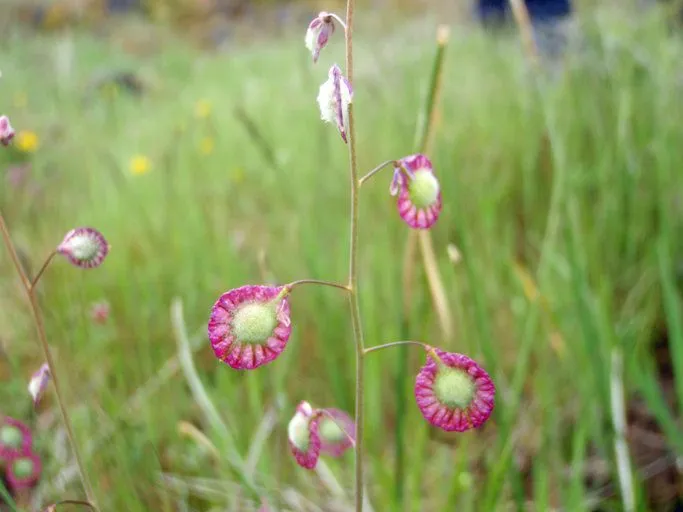
Author: Hook.
Bibliography: Fl. bor.-amer. 1:69. 1830
Year: 1830
Status: accepted
Rank: species
Genus: Thysanocarpus
Vegetable: False
Observations: W. Canada to Mexico (Baja California Norte, Sonora)
Fringepod, known scientifically as Thysanocarpus curvipes, is a distinguished member of the Brassicaceae family. This intriguing plant species was formally described in the early 19th century, with a notable mention in the Flora boreali-americana (Fl. bor.-amer.), an authoritative botanical reference from 1830.
The natural habitat of Thysanocarpus curvipes spans an impressive geographical range, stretching from the western regions of Canada down through the diverse terrains of Mexico, including areas such as Baja California Norte and Sonora. This expansive distribution highlights the plant’s adaptability to various climates and environments within North America.
Fringepod is particularly noted for its captivating seed pods, which are renowned for their unique fringed appearance. These distinctive fringes not only serve as a visual identifier but also contribute to the dispersal mechanisms, allowing the plant to propagate efficiently across its native regions.
In addition to its visual appeal, Thysanocarpus curvipes holds ecological significance within its native habitats. It contributes to the biodiversity of the regions where it is found and plays a role in the local ecosystems, possibly providing resources for various pollinators and other wildlife.
The intriguing combination of its broad distribution, unique morphological features, and ecological roles makes the Fringepod a fascinating subject of study for botanists and plant enthusiasts alike.
Eng: fringepod, lacepod, sand fringepod, sand lacepod, lacepod mustard
Fra: thysanocarpe à pédicelles recourbés
En: Fringepod, Lacepod, Sand fringepod, Lacepod mustard, Sand lacepod
Fr: Thysanocarpe à pédicelles recourbés
Taken Mar 4, 2008 by EOL − Jorg and Mimi Fleige (cc-by-nc)
Taken Dec 1, 1998 by EOL − Charles Webber (cc-by-nc-sa)
Taken Apr 6, 2009 by EOL − Irene Lindsey (cc-by-nc-sa)
Taken Oct 16, 1998 by EOL − Charles Webber (cc-by-nc-sa)
Taken Apr 18, 2019 by Caitlin McAvoy (cc-by-sa)
Taken Apr 19, 2021 by Megan Sweet (cc-by-sa)
Taken Dec 20, 2008 by EOL − Keir Morse (cc-by-nc-sa)
Taken Dec 7, 2005 by EOL − Steve Matson (cc-by-nc)
Taken Dec 7, 2005 by EOL − Steve Matson (cc-by-nc)
Taken Dec 7, 2005 by EOL − Steve Matson (cc-by-nc)
Taken Jun 29, 2011 by EOL − Gerald and Buff Corsi (cc-by-nc-sa)
Taken Dec 1, 1998 by EOL − Charles Webber (cc-by-nc-sa)
Taken Aug 2, 2013 by EOL − Scot Loring (cc-by-nc)
Taken Nov 8, 2009 by EOL − Barry Breckling (cc-by-nc-sa)
Taken Nov 4, 1999 by EOL − Dr. Robert T. and Margaret Orr (cc-by-nc-sa)
Taken Feb 24, 1999 by EOL − Beatrice F. Howitt (cc-by-nc-sa)
Taken Jun 7, 2000 by EOL − Charles Webber (cc-by-nc-sa)
Taken Mar 26, 2016 by EOL − Donna Pomeroy (cc-by-nc)
Taken Mar 31, 2016 by EOL − Donna Pomeroy (cc-by-nc)
Taken Dec 20, 2008 by EOL − Keir Morse (cc-by-nc-sa)
Taken Nov 8, 2008 by EOL − Keir Morse (cc-by-nc-sa)
Taken Dec 20, 2008 by EOL − Keir Morse (cc-by-nc-sa)
© copyright of the Board of Trustees of the Royal Botanic Gardens, Kew.
Growth habit>: Forb/herb
Family: Myrtaceae Author: (F.Muell.) K.D.Hill & L.A.S.Johnson Bibliography: Telopea 6: 402 (1995) Year: 1995 Status:…
Family: Rubiaceae Author: Pierre ex A.Froehner Bibliography: Notizbl. Bot. Gart. Berlin-Dahlem 1: 237 (1897) Year:…
Family: Sapindaceae Author: Koidz. Bibliography: J. Coll. Sci. Imp. Univ. Tokyo 32(1): 38 (1911) Year:…
Family: Asteraceae Author: A.Gray Bibliography: Pacif. Railr. Rep.: 107 (1857) Year: 1857 Status: accepted Rank:…
Family: Fabaceae Author: Medik. Bibliography: Vorles. Churpfälz. Phys.-Ökon. Ges. 2: 398 (1787) Year: 1787 Status:…
Family: Aspleniaceae Author: (Cav.) Alston Bibliography: Bull. Misc. Inform. Kew 1932: 309 (1932) Year: 1932…